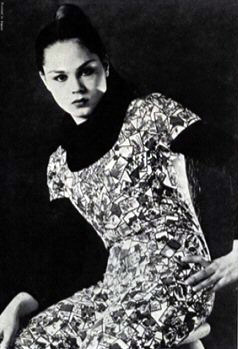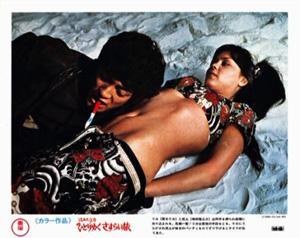Knee-high boots! Hot pants! Impossibly short skirts! A ridiculous cape! Panty shots! Dated lounge singing! An inordinate number of converging plot threads! Yes, Rica is back!
The film begins with Rica and a friend breaking out of juvenile hall. Once in their hideout, a girl named Midori arrives to bring news on Hanako, one of Rica’s friends from the first film who has gone missing. Midori has been followed  however, and the girls go to a local café to speak in private. Once there, Midori gets no further than telling Rica that Hanako is in Misawa and is in trouble before being shot in the head; the man that followed her to the hideout has also tailed them to the café. Rica chases the man into a shipyard, where they do battle and end up in the water. Before Rica is able to get any information, the man pulls out a Wakizashi (a Japanese short sword) and commits seppuku (ritual suicide).
however, and the girls go to a local café to speak in private. Once there, Midori gets no further than telling Rica that Hanako is in Misawa and is in trouble before being shot in the head; the man that followed her to the hideout has also tailed them to the café. Rica chases the man into a shipyard, where they do battle and end up in the water. Before Rica is able to get any information, the man pulls out a Wakizashi (a Japanese short sword) and commits seppuku (ritual suicide).
With no other information to go on, Rica heads to Misawa via train. She’s continually followed, and each time Rica gets the slip on the person trailing her by casually tossing them in front of an oncoming train between stops; one of the men trailing her though may actually be trying to protect her. Once she arrives, Rica runs into a little boy who’s looking for his father. Rica decides to accompany the boy home, and in casual conversation finds out the boys father has been missing since a ship named the Tohoku sank. Coincidentally, this is the last place her friend Hanako was seen before going missing.
Rica visits a lounge in Misawa looking for more information on Hanako. There she meets a singer named Kazumi, who worked with Hanako. While taking a walk, the two run into a man being chased by a group of thugs. Before being killed, he tells Rica that he worked on the Tohoku and that the men chasing him had locked him up. Rica and Kazumi take this news to the police, who shrug it off, although Rica does find out that Hanako is being held at the local mental hospital. Upon visiting the facility, Rica sees that Hanako does appear to have lost it.
Back at the lounge, a group of surviving crewmembers from the Tohoku confronts members of the Shimimura gang, accusing them of causing the ship to sink and holding the skipper against his will. Rica bides her time until the lounge closes, and attempts to extract some information from one of the crewmembers. Bad luck strikes again, as the man is killed  before Rica gets any information. This looks bad for Rica, as another man has been killed while in her company, with no other suspects in sight. The police are looking squarely at Rica, but one of the officers may be working for some bad guys on the side…but not the Shimimura gang. Who’s really behind all of this? Is Hanako really insane? Who’s the guy that’s trailing Rica, appearing to assist her? And most of all, how the hell does Rica get herself into these situations?
before Rica gets any information. This looks bad for Rica, as another man has been killed while in her company, with no other suspects in sight. The police are looking squarely at Rica, but one of the officers may be working for some bad guys on the side…but not the Shimimura gang. Who’s really behind all of this? Is Hanako really insane? Who’s the guy that’s trailing Rica, appearing to assist her? And most of all, how the hell does Rica get herself into these situations?
While the near-maddening nature of the winding plot doesn’t differentiate Rica 2: Lonely Wanderer from its predecessor, the change in direction taken by writer Kaneto Shindô does. Rather than make just another film about a girl gang, Shindô chose to shift the focus of the sequel squarely on Rica herself. While there are a number of other girls she comes into contact with throughout the film, their appearances are sparse, and the main light shines solely on Rica. This really helps to develop the character, and also gives actress Rika Aoki a lot of room to shine. Her acting ability here is much improved from the original installment; that could very well be why the choice was made to lay a good amount of the film in her hands.
Before I go any further, I’d like to point something out for those that hadn’t noticed yet. Yes, this film, as well as the other films in the trilogy, is written by Kaneto Shindô. For those unaware of Mr. Shindô’s work, he’s directed such highly-revered fare as Onibaba, Kuroneko, and The Naked Island, and has written scripts for directors like Kinji Fukusaku, Yasuzo Masumura, and Seijun Suzuki. Along with director Kô Nakahara, who emerged from the Japanese New Wave movement with films like Crazed Fruit, it’s easy to see that Pinky Violence attracted many creative filmmakers, and wasn’t a genre that existed exclusively for those of a lesser pedigree.
The lineage of those involved behind the scenes in Rica 2 show through in a number of aspects. Firstly, much like the original, the film is shot in a subdued style, which lets all of the action on screen speak for itself, without assisting it along with camera trickery. Along with the mostly muted color-palate, this offers the film a definite feeling of it being based in reality. In contrast, there’s a bizarre scene in the film that harkens back to the silent comedies of the 1920’s, accompanied by on-screen text and silent film-style parlor music.  It’s an odd choice, as it basically comes out of nowhere, but it does add a dash of uniqueness to the film, and is pretty amusing. Nakahara also has an affinity towards quick camera cuts, so you’ll have to stay particularly alert during the first part of the film if you want to keep up with all of the nuances the multiple story threads are attempting to convey, which ultimately tie up rather well.
It’s an odd choice, as it basically comes out of nowhere, but it does add a dash of uniqueness to the film, and is pretty amusing. Nakahara also has an affinity towards quick camera cuts, so you’ll have to stay particularly alert during the first part of the film if you want to keep up with all of the nuances the multiple story threads are attempting to convey, which ultimately tie up rather well.
As for the rest of film, it’s for the most part your standard Pinky Violence fare, albeit not on the same level as some of the true classics of the genre. The action scenes in the film were a step-up from the original, with a more “bang for your buck” feel. It’s unfortunate then that one of the fight scenes, which takes place outside, is way too dark. It was a nice idea to try and attempt to shoot an outdoor fight scene on a rock outcropping above the ocean with natural light, but the sun reflecting off of the water makes some of the action impossible to discern. Keeping in line with the original film, the “sex” side of things is very low, with only seconds of nudity to speak of. You’ll get panty shots and scantily clad ladies from time to time, but don’t expect copious amounts of bare flesh. The script also attempts to get a touch political, with American MP’s looking for a good time by randomly attacking Rica and a friend, but it gets nowhere near as involved as the first film did, and feels forced.
At the end of the day, Rica 2: Lonely Wanderer improves in some aspects when compared to the original, while it falters in others. Because of that, I honestly felt it was on par with the original, as they both had basically the same amount of good and bad elements. If you enjoyed the first, you’ll find much to enjoy here, especially if you were a fan of Rika Aoki’s character, as you’ll get to see a lot more of her. And really, who wouldn’t want more of those awesome legs?
Please feel free to discuss "Rica 2: Lonely Wanderer" here, in our forums!

